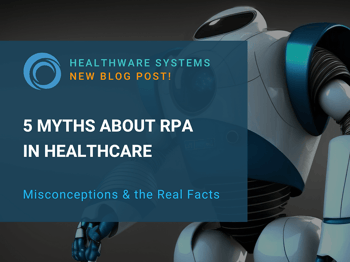What is Robotic Process Automation? (And How Can Healthcare Facilities Use RPA?)
Robotic process automation (RPA) is the use of software robots, also known as “bots,” to automate repetitive, human-based processes.
Robotic process automation is a means of achieving business process automation (BPA), which is the digital transformation, streamlining, and proactive management of organizational workflows.
Benefits of Robotic Process Automation
RPA is easy to implement because software robots interact directly with other software applications and websites using the existing user interface provided. The robot will log in to the application, navigate the user interface, populate fields, respond to prompts, capture results, and perform the same operations a human user would. Through assigned business rules, software robots can adapt to special use cases and outliers to handle virtually any scenario or work process.
Software robots take on the redundant, manual tasks usually completed by human users, which:
-
Enables staff to focus on higher-level objectives and interactions with patients.
-
Helps facilities better allocate resources and repurpose FTEs.
-
Lowers operational costs; using software robots is more affordable than hiring, training, housing, and paying humans to do repetitive, manual tasks.
-
Increases efficiency; bots work 24/7, don’t require time off, and can execute tasks more quickly than humans.
-
Improves accuracy; the opportunity for human error is significantly reduced.
-
Enhances data analytics; analyzing bots’ actions over humans’ is not only more precise, but robots can also be used to automate data aggregation and analysis.
-
Facilitates HIPAA compliance; all bot activity is tracked and documented.
-
Strengthens security; RPA follows all protocols/permissions for a normal user and meets the facility’s data integrity rules/conditions, plus removes risks tied to updates from external sources (e.g. vendors, business partners).
-
Requires minimal IT support and participation.
Robotic Process Automation in Healthcare
Bots can be deployed fully automated in an unattended configuration or utilized interactively. An interactive version may allow some human responses while automating other redundant activities.
Here are just a few areas where you can use robotic process automation in healthcare:
-
Order transcription
-
High-volume data entry
-
Cash posting
-
Benefits verification
-
Interactions with payer websites and clearinghouses
-
Claims and appeals
-
Progress note reporting
-
Vendor integration
-
Interoperability challenges
Is “RPA” in Your Site’s DNA?
RPA delivers a substantial return on investment and is essential to the future of healthcare organizations and how they operate.
HealthWare Systems can evaluate your workflows and user activities to identify and automate redundant actions. Contact us today to learn how we can help you apply RPA to your processes and experience the benefits at your healthcare facility.

